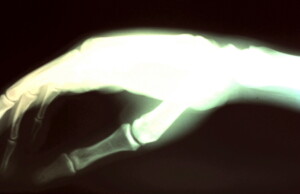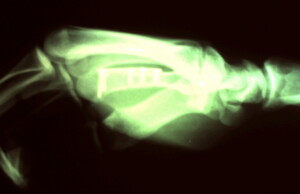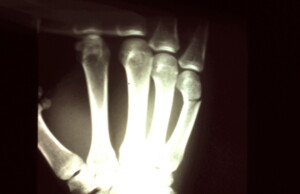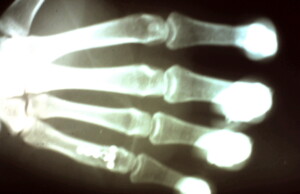ORIF 5th MC Boxer’s Fracture
A Boxer’s Fracture is another name for a break in the end of the little finger or 5th metacarpal bone. It is usually caused by punching something hard, such as a wall or another person’s head, thusly the name.. The end of the metacarpal bone takes the brunt of the impact, which usually breaks through the neck or the narrowest area of the bone. Casting or splinting the break is helpful to keep from injuring the area further, but without surgery, the break usually heals with a bend at the site of the break. The most reliable way to get the bones to heal straight is to use with pins or other hardware. This works well in most people – but is not usually needed, as most people do just fine even if the bone heals with a bit of a bend. Clawing can result from the palmar displacement of the metacarpal head, resulting from an imbalance of extrinsic tendons. Additionally, people who require a strong grip for work or athletic pursuits might find that the palmar flexed head of the metacarpal may be prominent in the palm can cause pain while gripping clubs, racquets, tools etc. and therefore surgical correction is sometimes recommended.
 Right 5th metacarpal fracture just proximal to the neck with some lateral translation.
Right 5th metacarpal fracture just proximal to the neck with some lateral translation.
 lateral view showing the head of the metacarpal flexed into the palm.
lateral view showing the head of the metacarpal flexed into the palm.
 This fracture was fixed with a 6 hole T-plate correcting the translation.
This fracture was fixed with a 6 hole T-plate correcting the translation.
 lateral view showing correction of the flexed metacarpal head, no longer prominent in the palm.
lateral view showing correction of the flexed metacarpal head, no longer prominent in the palm.
Classic Boxer’s Fracture.
 Classic Boxer’s Fracture pattern.
Classic Boxer’s Fracture pattern.
 T-plate used for fixation. Closed reduction and percutaneous pinning could be used for this type fracture but was attempted and reduction was not feasible.
T-plate used for fixation. Closed reduction and percutaneous pinning could be used for this type fracture but was attempted and reduction was not feasible.
 Slight extension lag commonly seen in the early post-operative period which should resolve with continued therapy.
Slight extension lag commonly seen in the early post-operative period which should resolve with continued therapy.





